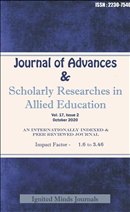Histochemical Analysis of Chickpea Seeds Infected with Fusarium Oxysporum
Impacts of Fusarium oxysporum on Chickpea Seed Quality and Production
Keywords:
chickpea seeds, Fusarium oxysporum, legume crop, chickpea production, protein quality, carbohydrate, proteins, world population, climate changeAbstract
Chickpea (Cicer arietinum L.) is an important legume crop, grown in more than 50 countries around the world. India accounts for approximately 75 chickpea production of the world with an area of 10.56 million hectares. It’s production is 10.23 million tonnes with an average productivity of 1063 kg per hectare (Economic survey 2017-18). Chickpea seeds are good source of carbohydrate and proteins and the protein quality is considered to be better than other pulses. (Jukanti A.K. and Gaur P.M. 2012, Roy et al 2010). Chick pea is valued crop and provides nutritious food for an expanding world population and will become increasingly important with climate change (Bulti Merga Jema Haji, 2019).Downloads
Download data is not yet available.
Published
2020-10-01
Issue
Section
Articles
How to Cite
[1]
“Histochemical Analysis of Chickpea Seeds Infected with Fusarium Oxysporum: Impacts of Fusarium oxysporum on Chickpea Seed Quality and Production”, JASRAE, vol. 17, no. 2, pp. 382–386, Oct. 2020, Accessed: Jan. 10, 2026. [Online]. Available: https://ignited.in/index.php/jasrae/article/view/12764











